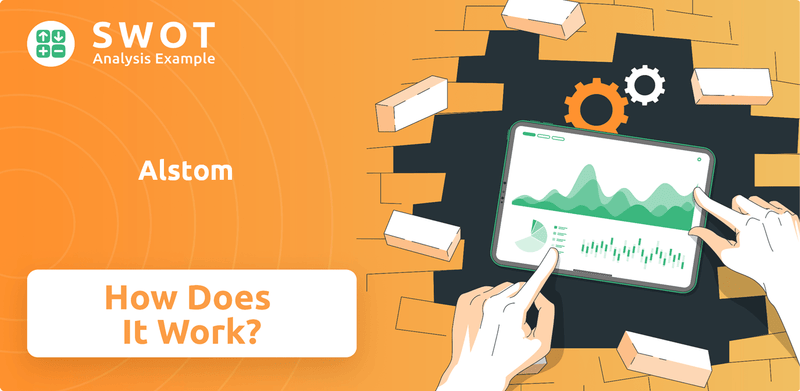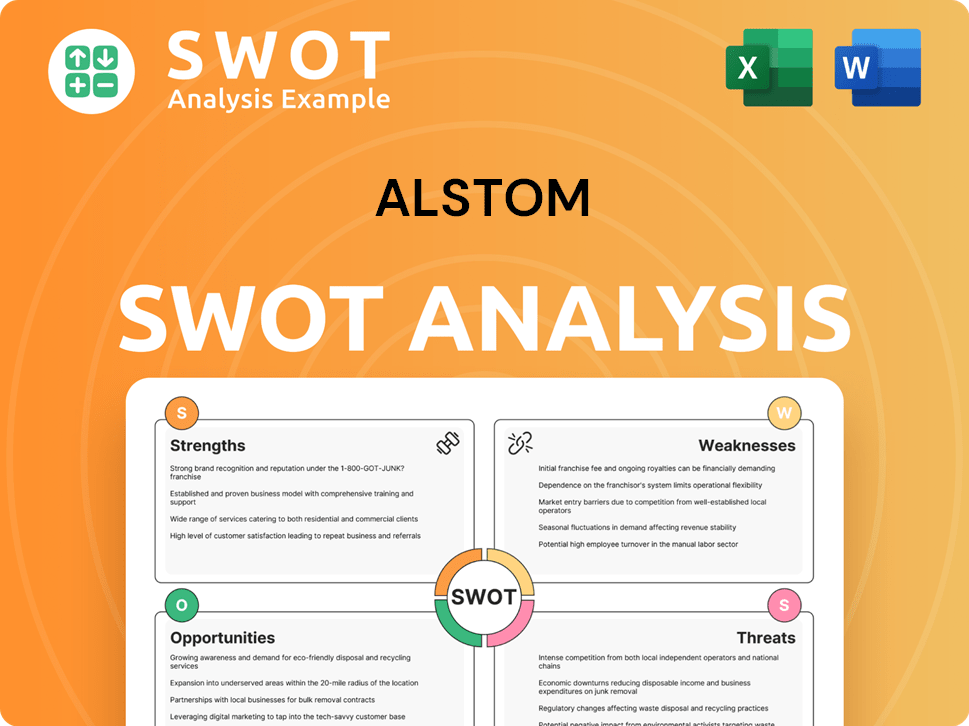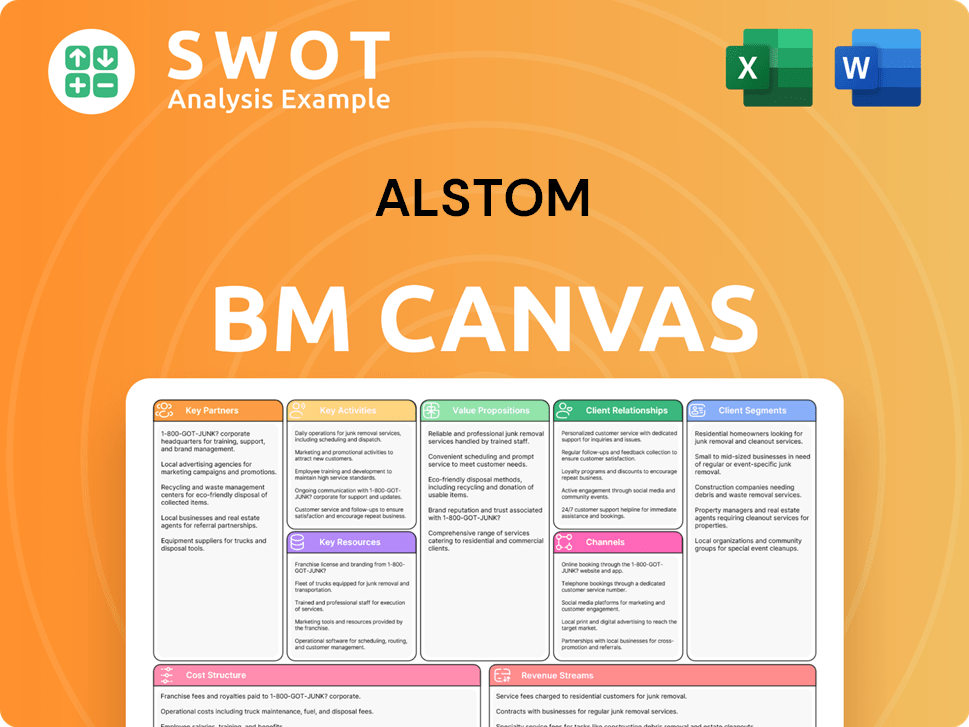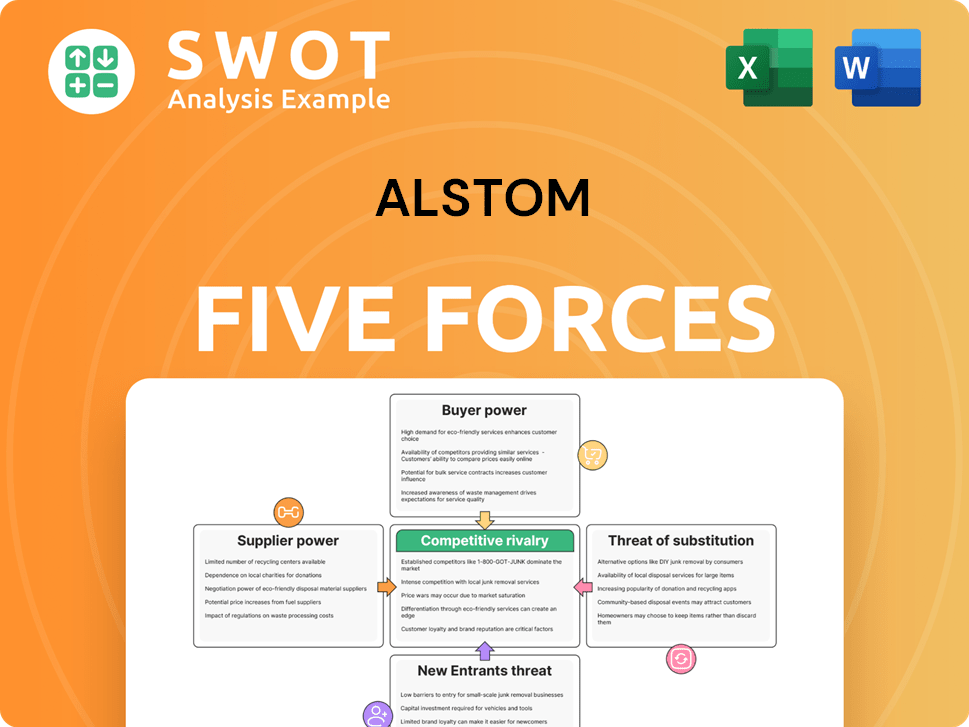Alstom Bundle
How Does Alstom Thrive in the Mobility Sector?
Alstom, a global powerhouse in sustainable mobility, is revolutionizing how we travel. With a vast portfolio spanning high-speed trains, metros, and signaling systems, Alstom is at the forefront of eco-friendly transportation. Its impressive financial performance, including a recent order intake of €18.9 billion, showcases its significant impact on the industry.

To truly understand Alstom's success, we must explore its Alstom SWOT Analysis, core Alstom operations, and diverse revenue streams. This deep dive will uncover how Alstom builds trains, manages its Alstom projects, and maintains its global presence. Whether you're interested in Alstom's railway solutions, its impact on transportation, or its sustainability initiatives, this analysis provides a comprehensive view of a leader in the field.
What Are the Key Operations Driving Alstom’s Success?
Alstom, a global leader in sustainable mobility, designs and delivers integrated solutions for the railway sector. The Alstom company focuses on providing a comprehensive range of products and services, from high-speed trains to signaling systems, serving a diverse customer base worldwide. Its operations are structured to support the entire lifecycle of railway projects, ensuring efficiency and long-term value for its clients.
The company's core business revolves around rolling stock, infrastructure, signaling, and services. Alstom operations are highly integrated, involving design, engineering, manufacturing, and maintenance. This integrated approach allows Alstom to offer complete railway solutions, enhancing passenger experience, and improving network efficiency. Growth Strategy of Alstom provides further insights into the company's strategic direction.
Alstom has a strong value proposition centered on integrated solutions and lifecycle support. This approach reduces operational costs, enhances passenger experience, and improves network efficiency. Alstom's focus on sustainable and digital mobility is a key differentiator in the market, aligning with global trends towards greener and smarter transportation systems.
Alstom manufactures various types of rolling stock, including high-speed trains, metros, and trams. These products are designed to meet the specific needs of different transportation systems globally. Alstom products are known for their reliability, energy efficiency, and passenger comfort.
Alstom provides infrastructure solutions such as track systems, electrification, and depot equipment. These components are essential for the smooth operation of railway networks. The infrastructure solutions support the long-term sustainability of Alstom projects.
The company offers advanced signaling systems to enhance safety and optimize traffic flow. These systems include train control, automation, and cybersecurity solutions. Alstom's signaling systems are crucial for modern railway operations.
Alstom provides comprehensive services, including maintenance, modernization, and digital solutions. These services ensure the long-term performance and reliability of railway assets. Alstom services are designed to meet the evolving needs of its customers.
Alstom's operations are characterized by a global manufacturing footprint and significant investments in research and development. The company has a strong emphasis on sustainability and digital mobility, which are key drivers of its business strategy. Alstom's commitment to innovation and customer satisfaction ensures its continued success in the railway industry.
- Global Manufacturing: Production sites strategically located worldwide.
- R&D: Focused on energy efficiency, digital connectivity, and autonomous capabilities.
- Supply Chain: Extensive network ensuring component availability.
- Distribution: Direct sales to government entities and transport operators.
Alstom SWOT Analysis
- Complete SWOT Breakdown
- Fully Customizable
- Editable in Excel & Word
- Professional Formatting
- Investor-Ready Format

How Does Alstom Make Money?
Understanding the revenue streams and monetization strategies of the Alstom company is crucial for grasping its financial health and market position. Alstom, a global leader in sustainable mobility, generates revenue through a diversified portfolio of products and services. The company's approach to generating income is multifaceted, ensuring both short-term gains and long-term financial stability.
Alstom's financial model is built on several key pillars, including product sales, services, signaling, and systems. These segments contribute to a robust revenue stream, supported by strategic monetization techniques. The company leverages its product offerings and service capabilities to maximize profitability and maintain a strong market presence.
Alstom operations are structured around four main segments, each contributing to the overall revenue. In the fiscal year 2023/24, Alstom reported total sales of €17.6 billion, demonstrating its significant market presence and financial performance. This financial success is a direct result of its effective revenue strategies and strong market position.
Alstom primarily generates revenue through the sale of its mobility solutions and related services. The company's revenue streams are categorized into four key segments: Rolling Stock, Services, Signalling, and Systems. Each segment contributes to Alstom's financial performance through various sales and service agreements.
- Rolling Stock: This segment includes the sale of high-speed trains, metros, and trams. These are typically large, long-term contracts.
- Services: This segment offers maintenance, modernization, and spare parts, providing recurring income. It also includes digital services for fleet optimization.
- Signalling: This division provides advanced signaling and train control systems, essential for railway safety and efficiency.
- Systems: This segment delivers integrated turnkey solutions, including electrification and infrastructure for transport networks.
Alstom PESTLE Analysis
- Covers All 6 PESTLE Categories
- No Research Needed – Save Hours of Work
- Built by Experts, Trusted by Consultants
- Instant Download, Ready to Use
- 100% Editable, Fully Customizable

Which Strategic Decisions Have Shaped Alstom’s Business Model?
The journey of the Alstom company has been marked by significant milestones and strategic shifts that have solidified its position in the global mobility market. These moves have been crucial in shaping its current structure and capabilities. Understanding these developments is key to grasping how Alstom operations function and its impact on the transportation sector.
A defining strategic move for Alstom was the acquisition of Bombardier Transportation in 2021. This acquisition significantly expanded Alstom's global footprint, product portfolio, and market share, particularly in Europe and North America. This strategic expansion has been a game-changer.
The acquisition of Bombardier Transportation, valued at approximately €5.5 billion, created a combined entity with a pro forma revenue of €15.7 billion in 2020. However, this integration also presented operational challenges, including supply chain disruptions and the need for significant restructuring. Alstom responded by implementing a comprehensive integration plan aimed at realizing synergies and optimizing its industrial footprint. For instance, in 2023, Alstom reported revenues of €16.5 billion, showcasing the impact of these strategic moves.
Alstom's technological prowess, particularly in high-speed rail and advanced signaling systems, provides a significant competitive advantage. This leadership is evident in its innovative solutions for railway solutions. The company's commitment to innovation ensures it remains at the forefront of the industry.
Alstom's strong brand recognition and reputation for delivering complex, high-quality projects globally enhance its competitive standing. This global presence allows Alstom to serve a diverse customer base. The company's projects span numerous countries, demonstrating its international reach.
Economies of scale, particularly after the Bombardier Transportation acquisition, allow Alstom to optimize production costs and invest more heavily in research and development. This efficiency helps Alstom to offer competitive pricing and enhance its product offerings. The integration of operations has led to significant cost savings.
The company's commitment to sustainable mobility solutions, such as hydrogen trains and digitalized transport systems, positions it favorably in a market increasingly prioritizing environmental performance. Alstom is actively involved in developing hydrogen fuel cell trains, showcasing its commitment to pioneering sustainable technologies. This focus aligns with global trends towards greener transportation.
Alstom continues to adapt to new trends, such as the increasing demand for autonomous transport solutions and predictive maintenance, by investing in digital technologies and fostering strategic partnerships with tech innovators. This proactive approach ensures that Alstom remains competitive in a rapidly evolving market. The company is focusing on digital technologies and strategic partnerships to stay ahead.
- Digitalization: Investing in digital technologies for predictive maintenance and smart transportation systems.
- Partnerships: Forming alliances with tech innovators to enhance its capabilities.
- Autonomous Transport: Exploring and developing autonomous transport solutions.
- Sustainability: Continuing to develop hydrogen trains and other sustainable technologies.
To gain a better understanding of the competitive landscape, you can explore the Competitors Landscape of Alstom. This offers insights into how Alstom competes within the industry.
Alstom Business Model Canvas
- Complete 9-Block Business Model Canvas
- Effortlessly Communicate Your Business Strategy
- Investor-Ready BMC Format
- 100% Editable and Customizable
- Clear and Structured Layout

How Is Alstom Positioning Itself for Continued Success?
The Alstom company holds a prominent position in the global railway industry. It competes with major players, including Siemens Mobility and CRRC. The acquisition of Bombardier Transportation significantly bolstered its market share, establishing it as a leading global entity.
Despite its strong market standing, the Alstom company faces several risks, including supply chain disruptions and intense competition. Technological advancements and regulatory changes also pose ongoing challenges. Alstom's future outlook is shaped by strategic initiatives focused on digitalization, sustainable transport technologies, and operational excellence.
Alstom is a leading player in the global railway market. Its global reach and extensive installed base contribute to strong customer loyalty. Alstom's operations span over 60 countries, underpinning its significant market presence.
Supply chain disruptions and raw material price volatility impact production schedules. The railway industry's competitive nature, marked by complex tenders, can lead to pricing pressures. Regulatory changes and technological advancements also pose challenges for Alstom.
Alstom is focused on digitalization and integrated mobility solutions. The company is investing in sustainable transport technologies, like hydrogen-powered trains. The company aims to secure large-scale projects and expand service revenues.
Alstom's order backlog, as of March 31, 2024, was at €91.7 billion, providing strong revenue visibility. The company's commitment to operational excellence and cost optimization supports profitability. The company is strategically positioned to grow its recurring service revenues.
Alstom is focused on accelerating digitalization and offering integrated mobility solutions. The company is developing sustainable transport technologies, such as hydrogen-powered trains. Alstom aims to secure large-scale projects and expand its recurring service revenues to drive growth.
- Digitalization of operations and services.
- Development of sustainable transport solutions.
- Focus on operational excellence and cost optimization.
- Expansion of recurring service revenues.
Alstom Porter's Five Forces Analysis
- Covers All 5 Competitive Forces in Detail
- Structured for Consultants, Students, and Founders
- 100% Editable in Microsoft Word & Excel
- Instant Digital Download – Use Immediately
- Compatible with Mac & PC – Fully Unlocked

Related Blogs
- What are Mission Vision & Core Values of Alstom Company?
- What is Competitive Landscape of Alstom Company?
- What is Growth Strategy and Future Prospects of Alstom Company?
- What is Sales and Marketing Strategy of Alstom Company?
- What is Brief History of Alstom Company?
- Who Owns Alstom Company?
- What is Customer Demographics and Target Market of Alstom Company?
Disclaimer
All information, articles, and product details provided on this website are for general informational and educational purposes only. We do not claim any ownership over, nor do we intend to infringe upon, any trademarks, copyrights, logos, brand names, or other intellectual property mentioned or depicted on this site. Such intellectual property remains the property of its respective owners, and any references here are made solely for identification or informational purposes, without implying any affiliation, endorsement, or partnership.
We make no representations or warranties, express or implied, regarding the accuracy, completeness, or suitability of any content or products presented. Nothing on this website should be construed as legal, tax, investment, financial, medical, or other professional advice. In addition, no part of this site—including articles or product references—constitutes a solicitation, recommendation, endorsement, advertisement, or offer to buy or sell any securities, franchises, or other financial instruments, particularly in jurisdictions where such activity would be unlawful.
All content is of a general nature and may not address the specific circumstances of any individual or entity. It is not a substitute for professional advice or services. Any actions you take based on the information provided here are strictly at your own risk. You accept full responsibility for any decisions or outcomes arising from your use of this website and agree to release us from any liability in connection with your use of, or reliance upon, the content or products found herein.